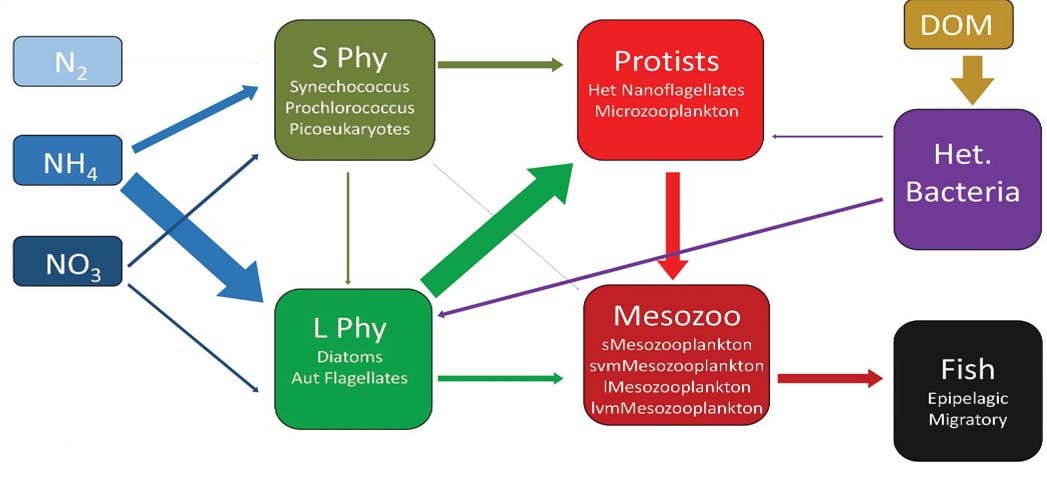Stable Isotopes and Trophic Analyses
Unraveling the trophic ecology of zooplankton is crucial to understanding their roles in marine foodwebs and biogeochemical cycles. Some zooplankton feed efficiently on the smallest algae in the ocean and hence are usually at a trophic level of 2. Others are ambush predators (or even parasites) of other zooplankton and hence may have trophic levels of 5 or higher. Most zooplankton, however, have variety in their diets. They might feed on algae, single-celled heterotrophs, other metazoan zooplankton, or even detritus. Determining the trophic level that an organism feeds at is important for estimating how much food is available to it now and in the future. Most of the ocean is nutrient limited, so food is scarce. Productivity is higher near the base of the food web, so if an organism is feeding on lower trophic levels it will have more food available to it than if it is feeding primarily on heterotrophic organisms.
Determining an organisms trophic position might sound straightforward. With some of the large animals that we are used to seeing on land, you can either watch them feed or look in their stomachs to see what they ate. However, observing microscopic organisms in the ocean is quite challenging and many types of prey are not well preserved within their guts. Instead we need alternate approaches for studying how their trophic position may change with changing ocean conditions.
Stable isotopes are one useful tool for studing zooplankton diets. Stable isotopes are atoms of the same element that have different numbers of neutrons. They hence behave very similarly with respect to most chemical reactions, but (in most cases) the lighter atom will react slightly faster leading to chemical fractionation. Both carbon and nitrogen have two common stable isotopes (12C and 13C for carbon; 14N and 15N for nitrogen). When we (or zooplankton) eat, we ingest material with the same isotopic signature as our prey (or in other words the same ratio of 13C:12C and 15N:14N). However, when we use that food we fractionate it. We preferentially use the lighter nitrogen during the chemical reactions that allow us to work, run, grow, breathe, etc. This means that we lose more 14N than 15N, leading the remainder (which makes up our bodies) with more 15N than our food. You are what you eat plus a few per mil nitrogen.
If we can measure the isotopic signatures (with respect to both carbon and nitrogen) of a zooplankton's prey and the zooplankton itself, we can use this information to figure out the different proportional roles of those prey types in their diet. This approach has been used successfully in many studies of seafloor organisms - because on the benthos it is relatively easily to separate out different prey types. However, zooplankton prey includes many types of phytoplankton, bacteria, and other zooplankton and these prey are well mixed in the ocean. It is thus often not possible to diffentiate the isotopic signatures of each prey type. We have thus developed a linear inverse modeling approach that allows us to combine isotopic data with other types of in situ measurements, including rate and biomass measurements (Stukel et al. 2018). With this approach, we have been able to determine that zooplankton in the Costa Rica Dome rely heavily on heterotrophic protists and detritus to supplement their diets because of the paucity of large algae in the system (Stukel et al. 2019). The plasticity in zooplankton diets in the Costa Rica Dome helps explain how the region can sustain large populations of fish, seabirds, and whales despite being dominated by tiny cyanobacteria. We next plan to use this approach to understand prey utilization by larval tuna in the Gulf of Mexico and food web roles of salps in the Chatham Rise.

This portion of our website is specifically designed as outreach to the general public. If you are a scientist look for details about our research, please click on the red 'For Scientists' link on the top right.
Contact: Mike Stukel (mstukel@fsu.edu)
Florida State University
Dept. of Earth, Ocean, and Atmospheric Science
Center for Ocean-Atmospheric Prediction Studies
